
Echinocactus grusonii Photo by: K.k. Agrawal
From panchkula cactus garden
Origin and Habitat: Central Mexico. Echinocactus grusoniiSN|3345]]SN|3345]] occurs in the Rio Moctezuma Valley (around the Zimapán Dam, Mesa de Léon ), Queretaro. A new subpopulation had been recently found in San Rafael de las Tablas, Zacatecas, the species has an extent of occurrence of approximately 4,500 km2 and there are two to four locations.
Altitude range: It grows at altitudes between 1,400 and 1,900 metres above sea level.
Habitat and ecology: The small subpopulation in Querétaro occurs on medium to steep slopes of volcanic rock near in a very small area (extent of occurrence is 25 km² and the area of occupancy is less than 10 km²). The total number of plants in the Querétaro subpopulation is estimated to be less than 1,000, the majority of which are mature. The subpopulations recently discovered in Zacatecas grow in semi-desert matorral, among volcanic rocks or calcareous soil on medium to steep slopes. These subpopulation are much larger and comprise several thousand mature individuals (the number is probably close to 10,000). The intense overcollection in its native habitat has led this plant becoming endangered in the wild, for this reason E. grusonii were the focus of an intensive rescue effort. In fact the Rio Moctezuma Valley, the native habitat of this cactus, was scheduled to be flooded after the construction of a major dam. A Mexican botanical garden hurried to remove these and other rare plants prior to the dam’s construction. Despite the fact that few plant remain in the wild today, their off-site conservation has allowed for extensive propagation by nurseries, and the golden barrel cactus is now one of the most common cacti in cultivation. Even though the two new subpopulation has thousands of individuals, there is continuing decline in the number of mature individuals due to illegal collection, as it is a very sought after species. The subpopulations are severely fragmented, and the genetic exchange between the two subpopulations is very unlikely.
Synonyms:
See all synonyms of Echinocactus grusonii
Common Names include:
ENGLISH: Golden Barrel, Mother-in-law's-cushion, Mother-in-law's-seat, Golden Ball Cactus, Golden Barrel Cactus, California Barrel Cactus
CHINESE (中文): 金琥, 象牙球
FINNISH (Suomi): Kultasiilikaktus, Anopinjakkara
FRENCH (Français): Coussin de belle-mère, Belle-mère
GERMAN (Deutsch): Schwiegermutterstuhl, Goldkugelkaktus
ITALIAN (Italiano): Cuscino della Suocera
JAPANESE (日本語): キンシャチ, キンシャチ(金鯱)
LITHUANIAN (Lietuvių): Geltondyglis ežiakaktusis
POLISH ( Polski): Złota beczka, Poduszka teściowej, Fotel teściowej
PORTUGUESE (Português): Assento de Sogra, Bola de Ouro, Cacto Barril Dourado
RUSSIAN (Русский): Эxинокактус Грузона, Эxинокактус Грусона, Эxинокактус грузона
SLOVENIAN (Slovenščina): Grusonov ježkar
SPANISH (Español): Biznaga tonel dorada, Biznaga Amarilla, Barril Dorado, Biznaga Dorada, Asiento de suegra, Bola de oro, Barril de oro, Cactus Erizo
SWEDISH (Svenska): Svärmors kudde
THAI (ภาษาไทย): ถังทอง
UKRAINIAN (Українська): Еxінокактус Грузона
Description: Echinocactus grusoniiSN|3345]]SN|3345]] has usually a single slowly growing globe-shaped stem that became elongated (barrel-shaped) in maturity, up to 90 cm (180 cm) in height and spread. It may offset with advanced age and a few multiples occur even at small sizes.
Stem: Pale green and heavily ribbed.
Ribs: With very numerous areoles.
Radial spines: Yellow spines.
Flowers: Flower are diurnal, vivid yellow (4-5 cm wide) and form a circular ring at the top of the plant, but are not very visible being small in relation with the size of the barrel, and lost into the creamy coloured wool at the plant apex.
Blooming season: The flowers are produced from end of spring to summer only on larger mature specimens receiving enough full sun.
Remarks: Like the other Echinocactus and Ferocactus seedlings, the rib structure is not yet apparent, and they have pronounced tubercles making them look superficially like Mammillarias.
Subspecies, varieties, forms and cultivars of plants belonging to the Echinocactus grusonii group
 Echinocactus grusonii Hildm.: It produces slowly growing barrel-shaped stem up to 90 cm (180 cm) in height and spread. The stem is pale green and heavily ribbed with very numerous areoles and golden yellow spines.
Echinocactus grusonii Hildm.: It produces slowly growing barrel-shaped stem up to 90 cm (180 cm) in height and spread. The stem is pale green and heavily ribbed with very numerous areoles and golden yellow spines. Echinocactus grusonii var. albispinus Y.Itô: It looks just like a regular "Golden Barrel" but the spines are glassy-white instead of yellow.
Echinocactus grusonii var. albispinus Y.Itô: It looks just like a regular "Golden Barrel" but the spines are glassy-white instead of yellow. Echinocactus grusonii var. albispinus f. cristatus hort.: crested form with spines all white instead of yellow.
Echinocactus grusonii var. albispinus f. cristatus hort.: crested form with spines all white instead of yellow. Echinocactus grusonii f. cristatus hort.: This is a wavy crested form with golden-yellow spines. It can also get very big making a spectacular specimen.
Echinocactus grusonii f. cristatus hort.: This is a wavy crested form with golden-yellow spines. It can also get very big making a spectacular specimen. Echinocactus grusonii var. intermedius hort.: This plant differs from the common Golden Barrel Cactus for the spines that are stout but intermediate in length between the standard from and the short spined type "subinermis" (syn: brevispinus).
Echinocactus grusonii var. intermedius hort.: This plant differs from the common Golden Barrel Cactus for the spines that are stout but intermediate in length between the standard from and the short spined type "subinermis" (syn: brevispinus).- Echinocactus grusonii var. intermedius f. cristatus hort.: Strong crested form with stout spines that are intermediate in length between the standard from and the short spined type "subinermis" (syn. brevispinus).
 Echinocactus grusonii var. intermedius f. variegatus hort.: Yellow and green, variegated plants with short, spines that are intermediate in length between the standard from and the short spined type "subinermis" (syn. brevispinus).
Echinocactus grusonii var. intermedius f. variegatus hort.: Yellow and green, variegated plants with short, spines that are intermediate in length between the standard from and the short spined type "subinermis" (syn. brevispinus). Echinocactus grusonii var. intertextus Y.Itô: (a.k.a "Krauskopf" or "tortulispinus") This plant differs from the common Golden barrel cactus for the spines, that are yellowish-white, sparse, flattish, curved to almost crinkled backward and very irregular, 2 to 6 cm long.
Echinocactus grusonii var. intertextus Y.Itô: (a.k.a "Krauskopf" or "tortulispinus") This plant differs from the common Golden barrel cactus for the spines, that are yellowish-white, sparse, flattish, curved to almost crinkled backward and very irregular, 2 to 6 cm long. Echinocactus grusonii var. intertextus f. cristatus hort.: Crested form with characteristich curved spines, that are flattish, almost crinkled backward and very irregular.
Echinocactus grusonii var. intertextus f. cristatus hort.: Crested form with characteristich curved spines, that are flattish, almost crinkled backward and very irregular. Echinocactus grusonii f. monstruosus cristatus hort.: Crested form of the mostrose cultivar covered by white wool with short yellow spines. The crests are quite unstable
Echinocactus grusonii f. monstruosus cristatus hort.: Crested form of the mostrose cultivar covered by white wool with short yellow spines. The crests are quite unstable Echinocactus grusonii f. monstruosus hort.: Free offsetting small form covered by yellowhish-white wool with short yellow spines. The rib structure is not yet apparent, and they have pronounced tubercles making them look superficially like Mammillarias.
Echinocactus grusonii f. monstruosus hort.: Free offsetting small form covered by yellowhish-white wool with short yellow spines. The rib structure is not yet apparent, and they have pronounced tubercles making them look superficially like Mammillarias. Echinocactus grusonii var. setispinus f. minor cristatus hort.: This is the tiniest crested form. A dwarf form covered by touch friendly spines and looking quite dissimilar to the standard species.
Echinocactus grusonii var. setispinus f. minor cristatus hort.: This is the tiniest crested form. A dwarf form covered by touch friendly spines and looking quite dissimilar to the standard species. Echinocactus grusonii var. setispinus f. minor mostruosus cristatus cv. Scarascia: The plant forms lots of tiny monstrous wooly heads, that time by time begin to crest.
Echinocactus grusonii var. setispinus f. minor mostruosus cristatus cv. Scarascia: The plant forms lots of tiny monstrous wooly heads, that time by time begin to crest. Echinocactus grusonii f. setispinus hort.: This cultivar has very thin acicular spines, that become longer as the plant ages.
Echinocactus grusonii f. setispinus hort.: This cultivar has very thin acicular spines, that become longer as the plant ages. Echinocactus grusonii var. subinermis Y.Itô: (a.k.a. "cv. TOGENASHI KINSHACHI", "inermis" or "brevispinus") This is very short spined mutantant. Except for the spines it is identical in shape and size to the standard species.
Echinocactus grusonii var. subinermis Y.Itô: (a.k.a. "cv. TOGENASHI KINSHACHI", "inermis" or "brevispinus") This is very short spined mutantant. Except for the spines it is identical in shape and size to the standard species. Echinocactus grusonii var. subinermis f. cristata hort.: This is the crested form of the short-spined Golden Barrel. This crest can also get very large
Echinocactus grusonii var. subinermis f. cristata hort.: This is the crested form of the short-spined Golden Barrel. This crest can also get very large
Notes: Older specimens take on an oblong shape with age. They also tend to lean to the south or southwest so that the spines can better protect the body of the plant from the harsh desert sun. In fact, desert travellers can use the plant as a compass.
Bibliography: Major references and further lectures
1) Edward Anderson “The Cactus family” Timber Press, Incorporated, 2001
2) James Cullen, Sabina G. Knees, H. Suzanne Cubey "The European Garden Flora Flowering Plants: A Manual for the Identification of Plants Cultivated in Europe, Both Out-of-Doors and Under Glass" Cambridge University Press, 11/Aug/2011
3) David R Hunt; Nigel P Taylor; Graham Charles; International Cactaceae Systematics Group. "The New Cactus Lexicon" dh books, 2006
4) N. L. Britton, J. N. Rose “The Cactaceae. Descriptions and Illustrations of Plants of the Cactus Family.” Volume 4, The Carnegie Institution of Washington, Washington 1923.
5) Forest & Kim Starr Echinocactus grusonii (Golden barrel cactus). Plants of Hawaii. <http://www.starrenvironmental.com>. Downloaded on 21 August 2014.
6) Guadalupe Martínez, J., Sánchez , E. & Gómez-Hinostrosa, C. 2013. Echinocactus grusonii. The IUCN Red List of Threatened Species 2013: e.T40962A2947851. http://dx.doi.org/10.2305/IUCN.UK.2013-1.RLTS.T40962A2947851.en. Downloaded on 25 March 2016.
7) Hunt, D. “CITES Cactaceae Checklist”, 2nd ed. Royal Botanic Gardens, Kew and International Organization for Succulent Plant Study (IOS). 1999.
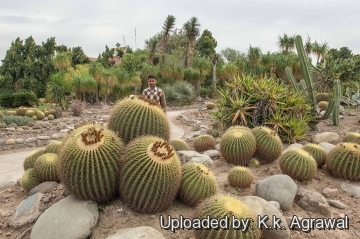 From panchkula cactus garden.Dedicated worker in the garden. Photo by: K.k. Agrawal
From panchkula cactus garden.Dedicated worker in the garden. Photo by: K.k. Agrawal Flowers at Lualailua, Maui, Hawaii (USA). March 20, 2007. Photo by: Forest Starr & Kim Starr
Flowers at Lualailua, Maui, Hawaii (USA). March 20, 2007. Photo by: Forest Starr & Kim Starr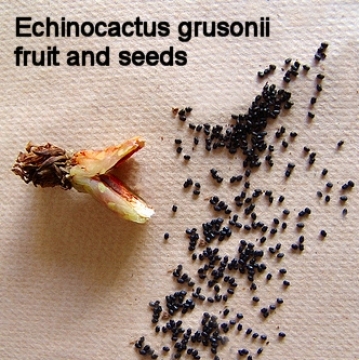 Echinocactus grusonii Photo by: Cactus Art
Echinocactus grusonii Photo by: Cactus Art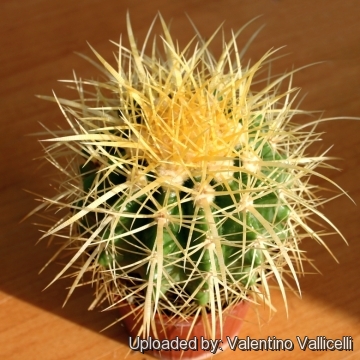 Echinocactus grusonii Photo by: Valentino Vallicelli
Echinocactus grusonii Photo by: Valentino Vallicelli Habit at Nong Nooch Tropical Botanical Garden - 07 2009 Photo by: Raimondo Paladini
Habit at Nong Nooch Tropical Botanical Garden - 07 2009 Photo by: Raimondo Paladini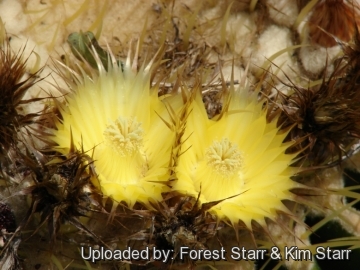 Flowers at Lualailua, Maui, Hawaii (USA). March 20, 2007. Photo by: Forest Starr & Kim Starr
Flowers at Lualailua, Maui, Hawaii (USA). March 20, 2007. Photo by: Forest Starr & Kim Starr - The seedlings have pronounced tubercles making them look superficially like Mammillarias. Photo by: Cactus Art
- The seedlings have pronounced tubercles making them look superficially like Mammillarias. Photo by: Cactus Art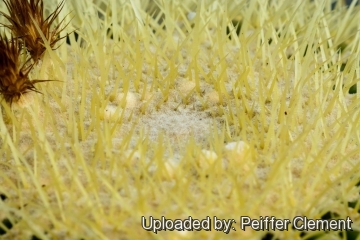 Echinocactus grusonii Photo by: Peiffer Clement
Echinocactus grusonii Photo by: Peiffer ClementCultivation and Propagation: Echinocactus grusoniiSN|3345]]SN|3345]] are summer-growing and pretty easy plants to cultivate. They are suited for any rich, well drained soil such us clay, pumice, lava grit, and only a little peat or leaf-mould. If potted, repot preferably in the spring, if their roots become cramped. Generally, they should be repotted every other year in order to provide fresh soil. However, this doesn't necessarily mean they'll need larger containers. Fill about a quarter of the pot with broken crocks, gravel, etc. to promote good drainage. After repotting, do not water for a week or more. Water regularly during the aestival growth cycle (this plant need plenty of water, but do not overwater and let their soil dry out between waterings), and also needs to be avoided wetting the body of this plant while it is in sunlight. A wet cactus in the sun light can cause sun burning which can lead to scars or even fungal infections and death, keep rather dry in winter. No water should ever be allowed to stand around the roots. Feed with a high potassium fertilizer in summer.
Exposure: Outside they need a bright exposure, full sun or half shade in summer if the location is exceedingly hot or bright, inside needs bright light, and some direct sun. It can tolerate moderate shade, and a plant that has been growing in shade should be slowly hardened off before placing it in full sun as the plant will be severely scorched if moved too suddenly from shade into sun.
Frost Tolerance: Light frost protection required for safe cultivation, but can tolerate sporadic light frost.
Diseases and pests: Watch for infestations of mealybug, scale insects and spider mite. Plant in good conditions will start to bloom when reach the diameter of 40-50 cm.
Uses: Echinocactus grusoniiSN|3345]]SN|3345]] is a wonderful popular plant for adding texture, colour and shape to landscapes, it gives a huge dose of impact. The striking round shape and the dramatic golden bright-yellow spines that absolutely light up in daylight, especially when backlit are unique. It is an eye catcher without equal. Unlike many plants, the "golden barrels" get more and more beautiful as they grow. As old specimens they can be truly majestic. They are best planted close together among large rocks or boulders.
Propagation: From seeds. Echinocactus grusoniiSN|3345]]SN|3345]] will produce hundreds of fruits each season. Several months after the flower dies off and the pods are ripen it is possible to collect them from under the dried flower. The pods will come off with a slight twist, leaving the wool on the cactus. Use a knife to slice down one side of the pod to expose the seed and scrape them out. The seeds are mahogany or reddish amber and tiny. Then place the seeds in some water to soak overnight. Fill germination trays with a well blended mixture of 60% peat moss 40% vermiculite and one to one part of coarse sand or pumice. Use a horse syringe to suck the small seeds and some of the water into the syringe. With the syringe, distribute the seeds evenly in the germination tray, shaking the syringe so the seeds don't settle at the bottom and all come out at once. Some growers also recommend to cold-stratify seeds in a refrigerator for a year prior to sow them. But can also be used dry seeds too. Place then the trays in filtered sun, cover with a glass sheet and keep the soil moist until the seeds germinate in approximately 2 to 6 weeks. They will look like small spheres, red in colour not green. Then gradually remove the glass cover. When the small cacti start to sprout tiny spines, use a pair of tweezers to transfer them from the propagation trays into 5 cm pots filled with the same soil mix used in the germination trays. Allow the small cacti to grow for about one/two year and then move the cacti to 10 cm pots and allow them to grow further.
Your Photos
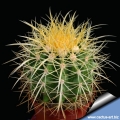
by Cactus Art
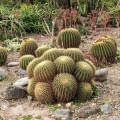
by K.k. Agrawal

by K.k. Agrawal





















